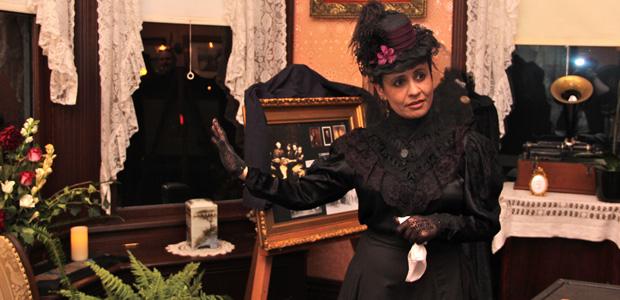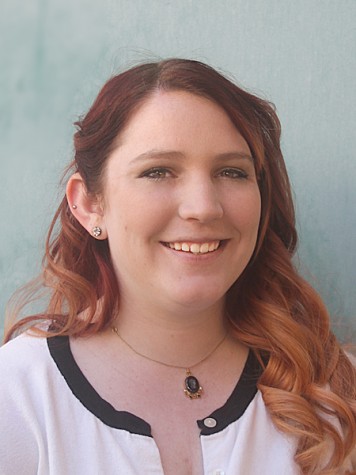Caskets, postmortem photos and hair jewelry — not the typical things to see during a night out in Glendale.
But in in the spirit of Halloween, the Glendale Historical Society hosted “Beneath the Veil,” a one-night exhibit on Saturday on death and mourning during the Victorian era at the Doctor’s House in Brand Park, featuring authentic mourning attire, hair jewelry and postmortem photographs.
“We wanted it [the exhibit] to appeal to all the senses: sights, sounds and tastes,” said Peter Rusch, assistant director of the Doctor’s House.
Set in an authentic Victorian house, the exhibit accomplished just that. Solemn music played throughout the house while guests viewed rooms with different customs of mourning in the Victorian era. At the end of the tour, guests were invited to try a butternut squash soup, which would have been traditionally offered to guests by the widow at a wake in Victorian times.
“There was no other way than to physically show it [mourning during Victorian times],” said Sonia Montejano, director of the Doctor’s House. “I think people leave with that realism.”
“Beneath the Veil” wasn’t just an exhibit on Victorian death and mourning, it was an entire experience.
The scene was set around a volunteer who was “dead.” Guests were invited into the house where volunteers, dressed in traditional clothes, stayed in character while they explained that their friend had passed away. Each of the rooms showed different aspects of death in mourning during the Victorian era.
Before guests entered the house, former Glendale Historical Society board members Joe Selph and Marty Bracciotti greeted guests while showcasing an authentic 19th century transport casket. They explained that the transport casket was replaced by the modern-day body bag. They went on to tell guests the origins of the term “dead ringer.”
Guests then entered the house where the first room contained a prop coffin that had an authentic Victorian quilt made from the remnants of mourning clothes draped over it.
“They say Victorians were obsessed with death,” said Mireya Romo-Bowen, a docent in the first room. “I don’t know if they were obsessed, but definitely accepting.”
Guests then went on to the doctor’s study where a volunteer played the deceased’s doctor where he asked what more could he have done for the deceased, since doctors couldn’t do more than console patients during the Victorian era. He continued on to say that he hoped in the future there would be a cure for such diseases as the influenza.
The next room showed the history of cemeteries and mausoleums in Glendale. The Glendale Historical Society displayed the meanings of things engraved on tombstones.
Next, guests traveled upstairs where there were two exhibits: one on postmortem photography and the other on hair jewelry.
“The creepiest part was the postmortem photos,” said Burbank resident Cherie Chrusan, 32. “They were really disturbing.”
A somewhat common practice during the Victorian era was to pose the deceased in a life-like position for a portrait. A volunteer explained that the photographers painted on the eyes so the deceased looked more alive.
The hair jewelry room displayed intricate jewelry made exclusively out of human hair. According to a docent, this was a common way to remember the deceased.
Guests then returned downstairs where the “dead” member of the Glendale Historical Society lay next to his grieving widow. Guests were given roses to pay their respects to the dead.
“The dead guy was breathing,” said Burbank resident Dixie Chrusan, 63. “I said, ‘I’m not going to put my rose up there because he’s going to sit up!’”
However, the volunteer never broke character and never sat up to scare anyone.
“Our objective was to inform,” said Rusch. “We didn’t want to make it scary and creepy.”
After touring the house, guests didn’t come running out screaming, but left with a wealth of knowledge.
“I learned so much about the death traditions,” said Laura Miller, a GCC instructional computer lab technician. “I thought it was breathtaking, exquisite, gorgeous and authentic.”
The Glendale Historical Society created this exhibit not only to educate people about Victorian death and mourning, but also to create awareness about the Doctor’s House and its history.
The Doctor’s House is open every Sunday for tours from 2 to 4 p.m. The next special event that the Glendale Historical Society will host at the Doctor’s House will be holiday candlelight tours on Dec. 8 and 15.
For more information on the Glendale Historical Society and the Doctor’s House visit http://www.glendalehistorical.org.


